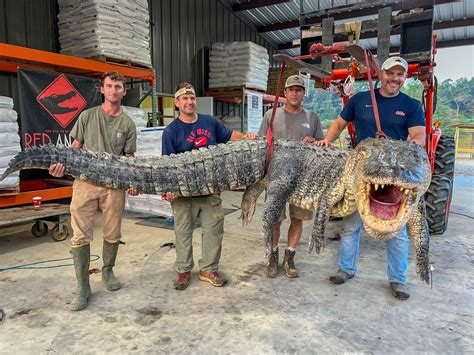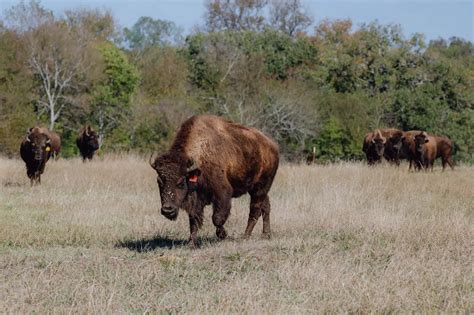
A massive 400-pound alligator, estimated to be around 12 feet long, was captured in North Carolina on Monday after residents reported seeing the enormous reptile in a residential area. The alligator, deemed a safety concern due to its size and proximity to populated areas, was successfully relocated by licensed wildlife experts.
A colossal alligator, weighing approximately 400 pounds and stretching nearly 12 feet in length, was apprehended in a residential neighborhood in North Carolina on Monday, prompting a swift response from local wildlife authorities. The North Carolina Wildlife Resources Commission (NCWRC) confirmed the capture and relocation of the reptile, emphasizing the potential danger it posed to residents and pets. Residents initially spotted the behemoth saurian near a neighborhood pond, triggering immediate concerns given the proximity to homes and recreational areas.
“It was a safety concern, obviously, at that size and in that location,” stated a spokesperson for the NCWRC, highlighting the rationale behind the decision to capture and relocate the alligator. The NCWRC collaborated with licensed alligator trappers experienced in safely handling and transporting large reptiles. The capture involved a coordinated effort using specialized equipment designed to restrain the animal without causing undue harm.
The alligator was subsequently moved to a more suitable habitat away from residential areas, ensuring both its safety and the safety of the public. The exact location of the relocation site was not disclosed to prevent potential disturbances to the animal and its new environment. Experts believe the alligator’s presence in the residential area may have been due to a combination of factors, including habitat loss, increased alligator populations in the region, and the animal’s natural search for food and territory.
Alligator populations have been steadily increasing in North Carolina over the past several decades, largely due to successful conservation efforts. These efforts include habitat restoration and protection, as well as regulations governing hunting and trapping. While alligators are native to the southeastern part of the state, their range has been expanding northward and westward, leading to more frequent encounters with humans.
The NCWRC advises residents to exercise caution in areas where alligators are known to inhabit, particularly near bodies of water. The commission recommends keeping a safe distance from alligators, avoiding feeding them (as this can lead to habituation and increased aggression), and keeping pets on a leash when walking near alligator habitats. Residents are also encouraged to report any nuisance alligators to the NCWRC for assessment and potential relocation.
The recent capture serves as a reminder of the importance of responsible wildlife management and the need for public awareness regarding human-wildlife interactions. The NCWRC continues to monitor alligator populations throughout the state and implement strategies to minimize conflicts between humans and these impressive reptiles.
The incident highlights the delicate balance between conservation efforts and public safety, underscoring the need for ongoing education and proactive measures to ensure the well-being of both humans and wildlife. The successful capture and relocation of the 400-pound alligator represent a positive outcome, demonstrating the effectiveness of collaborative efforts between wildlife authorities and experienced trappers in managing potentially dangerous situations. The incident is under review to understand any factors that caused the Alligator to be in the residential area, and how this might be prevented in the future.
Expanded Context and Background Information
The American alligator (Alligator mississippiensis) is a large reptile native to the southeastern United States. They are apex predators, playing a crucial role in maintaining the balance of their ecosystems. Alligators primarily inhabit freshwater environments such as swamps, marshes, rivers, and lakes. They are opportunistic feeders, consuming a wide variety of prey, including fish, turtles, birds, and mammals.
Alligator populations in North Carolina were once severely depleted due to overhunting and habitat loss. However, thanks to successful conservation efforts, their numbers have rebounded significantly. The NCWRC has implemented various management strategies to ensure the long-term viability of alligator populations while also addressing potential conflicts with humans.
These strategies include:
-
Habitat Protection and Restoration: Protecting and restoring vital alligator habitats, such as wetlands and riparian areas, is crucial for supporting healthy populations.
-
Regulations on Hunting and Trapping: The NCWRC regulates alligator hunting and trapping to prevent overexploitation and ensure sustainable harvest levels. Hunting seasons and bag limits are carefully established based on population assessments and scientific data.
-
Public Education and Outreach: Educating the public about alligator behavior, safety precautions, and the importance of conservation is essential for minimizing human-alligator conflicts.
-
Nuisance Alligator Management: The NCWRC responds to reports of nuisance alligators that pose a threat to public safety. Licensed trappers are authorized to capture and relocate or, in some cases, euthanize these animals. Relocation is prioritized whenever possible, but euthanasia may be necessary if the alligator is deemed too aggressive or has become habituated to humans.
The increase in alligator sightings in residential areas can be attributed to several factors, including:
-
Habitat Loss: As human development encroaches on natural habitats, alligators are forced to seek refuge in areas closer to human settlements.
-
Increased Alligator Populations: The success of conservation efforts has led to larger alligator populations, increasing the likelihood of encounters with humans.
-
Food Availability: Alligators may be attracted to residential areas by the presence of food sources, such as pet food, garbage, or even small pets.
-
Territorial Disputes: During breeding season, alligators may become more active and territorial, leading them to wander into unfamiliar areas.
The NCWRC emphasizes the importance of responsible behavior in areas where alligators are present. Residents should:
-
Never Feed Alligators: Feeding alligators can cause them to lose their fear of humans and associate people with food, leading to dangerous encounters.
-
Keep a Safe Distance: Maintain a safe distance from alligators, and never approach or attempt to handle them.
-
Keep Pets on a Leash: When walking pets near alligator habitats, keep them on a leash to prevent them from becoming prey.
-
Avoid Swimming in Alligator-Infested Waters: Swim only in designated swimming areas that are known to be alligator-free.
-
Be Aware of Your Surroundings: Pay attention to your surroundings and be aware of potential alligator hazards.
-
Report Nuisance Alligators: Report any nuisance alligators to the NCWRC for assessment and potential relocation.
The recent capture of the 400-pound alligator serves as a reminder of the importance of respecting wildlife and taking precautions to avoid conflicts. By following these guidelines, residents can help ensure their safety and the well-being of alligators in North Carolina.
Analysis of the Incident
The capture of the large alligator in North Carolina raises several important questions about human-wildlife interactions and the management of potentially dangerous animals. While the successful relocation of the alligator is a positive outcome, it also highlights the need for ongoing vigilance and proactive measures to prevent future conflicts.
One key issue is the impact of habitat loss and fragmentation on alligator populations. As human development continues to expand, alligators are increasingly forced to compete for limited resources and seek refuge in areas closer to human settlements. This can lead to increased encounters between humans and alligators, raising the risk of attacks or other incidents.
Another important consideration is the role of human behavior in attracting alligators to residential areas. Feeding alligators, leaving pet food or garbage accessible, or creating artificial water sources can all contribute to habituation and increased aggression. By taking steps to minimize these attractants, residents can help reduce the likelihood of alligator encounters.
The NCWRC’s management strategies for alligators appear to be effective in maintaining healthy populations while also addressing potential conflicts with humans. However, ongoing monitoring and adaptation are essential to ensure the long-term success of these strategies. The commission should continue to invest in research, public education, and nuisance alligator management to minimize the risk of future incidents.
In addition, local communities should work together to develop comprehensive plans for managing human-wildlife interactions. These plans should include strategies for habitat protection, public education, and response to nuisance animals. By working collaboratively, communities can create a safer environment for both humans and wildlife.
The incident also underscores the importance of responsible pet ownership. Pets can be particularly vulnerable to alligator attacks, especially when they are allowed to roam freely near alligator habitats. Keeping pets on a leash and avoiding areas known to be frequented by alligators can help protect them from harm.
Furthermore, the incident highlights the need for clear communication and coordination between wildlife authorities, local law enforcement, and the public. When an alligator is sighted in a residential area, it is crucial to have a well-defined protocol for responding to the situation. This protocol should include procedures for assessing the threat, capturing or relocating the alligator, and informing the public about potential risks.
The successful resolution of the recent alligator capture demonstrates the effectiveness of collaborative efforts between wildlife authorities and experienced trappers. However, it is important to recognize that this is just one incident in an ongoing process of managing human-wildlife interactions. By continuing to invest in research, education, and management strategies, North Carolina can ensure the long-term coexistence of humans and alligators.
Ecological Significance of Alligators
Beyond the immediate concerns of public safety, it’s crucial to understand the ecological role of alligators within their native environment. Alligators are considered a keystone species, meaning they play a critical role in maintaining the health and stability of their ecosystems.
One of the most significant ways alligators contribute to their environment is through the creation and maintenance of “alligator holes.” These are depressions in the landscape that alligators dig and maintain, often providing a refuge for other aquatic species during periods of drought. Alligator holes can also serve as important breeding grounds for fish, amphibians, and reptiles.
In addition, alligators help to control populations of various prey species, preventing any single species from becoming dominant and disrupting the balance of the ecosystem. Their feeding habits also contribute to nutrient cycling, as they consume decaying organic matter and release nutrients back into the environment.
Alligators also play a role in shaping the vegetation of their habitats. Their movements can help to clear vegetation and create open areas, promoting biodiversity and providing habitat for a variety of plant and animal species.
The presence of alligators can also have economic benefits. Alligator hunting and trapping provide a source of income for some communities, while ecotourism focused on alligator watching can generate revenue for local businesses.
However, the ecological benefits of alligators must be balanced against the potential risks they pose to humans. It is important to manage alligator populations in a way that minimizes conflicts while also preserving their important ecological functions.
Long-Term Management Strategies
To ensure the long-term coexistence of humans and alligators in North Carolina, a comprehensive and adaptive management approach is needed. This approach should include the following elements:
-
Habitat Conservation and Restoration: Protecting and restoring vital alligator habitats is essential for supporting healthy populations and minimizing the need for alligators to venture into residential areas. This can involve acquiring land, implementing conservation easements, and restoring degraded wetlands.
-
Population Monitoring and Assessment: Regular monitoring of alligator populations is necessary to track their size, distribution, and health. This information can be used to adjust management strategies as needed and to assess the effectiveness of conservation efforts.
-
Public Education and Outreach: Educating the public about alligator behavior, safety precautions, and the importance of conservation is crucial for minimizing human-alligator conflicts. This can involve creating educational materials, conducting workshops, and partnering with local schools and community organizations.
-
Nuisance Alligator Management: A well-defined protocol for responding to reports of nuisance alligators is essential for protecting public safety. This protocol should include procedures for assessing the threat, capturing or relocating the alligator, and informing the public about potential risks.
-
Research and Innovation: Continued research is needed to better understand alligator ecology, behavior, and population dynamics. This knowledge can be used to develop more effective management strategies and to address emerging challenges, such as the impacts of climate change.
-
Community Engagement: Engaging local communities in the management of alligators is essential for building support for conservation efforts and for ensuring that management strategies are tailored to local needs and concerns.
-
Adaptive Management: Management strategies should be adaptive, meaning they are regularly reviewed and adjusted based on new information and changing conditions. This ensures that management efforts remain effective and responsive to evolving challenges.
By implementing these strategies, North Carolina can continue to manage alligator populations in a way that balances the needs of both humans and wildlife. This will help to ensure the long-term coexistence of humans and alligators in the state.
Frequently Asked Questions (FAQs)
-
How common are alligators in North Carolina? Alligators are native to the southeastern part of North Carolina, primarily in the coastal plain. Their populations have been increasing due to successful conservation efforts, leading to more frequent sightings in recent years, including areas further north and west than their historical range.
-
What should I do if I encounter an alligator? The NCWRC recommends maintaining a safe distance from the alligator. Do not approach or attempt to feed it. Keep pets on a leash and away from the alligator. If the alligator poses an immediate threat, contact local law enforcement or the NCWRC.
-
Why was the alligator captured and relocated instead of being left alone? The alligator was captured and relocated because its size and location near a residential area posed a significant safety risk to residents and pets. Relocation is often the preferred option when alligators are deemed a nuisance or a threat to public safety.
-
What happens to alligators after they are captured? Captured alligators are typically relocated to a more suitable habitat away from residential areas. The exact location of the relocation site is usually kept confidential to prevent disturbances to the animal and its new environment. In some cases, if the alligator is deemed too aggressive or has become habituated to humans, euthanasia may be considered as a last resort.
-
How can I prevent alligators from coming onto my property? To prevent alligators from coming onto your property, avoid feeding them, as this can cause them to lose their fear of humans. Keep pet food and garbage securely stored. Clear brush and vegetation around ponds or waterways to reduce hiding places. If you have a pond on your property, consider installing a fence to keep alligators out.









